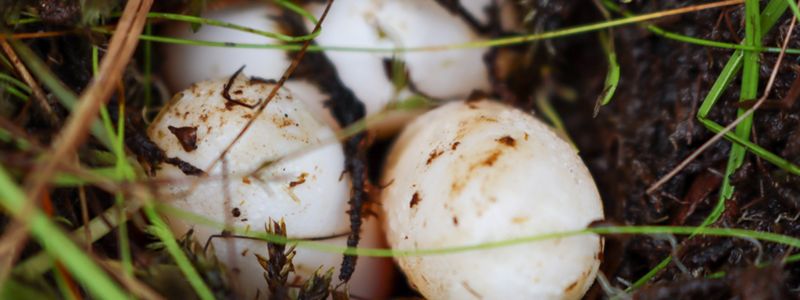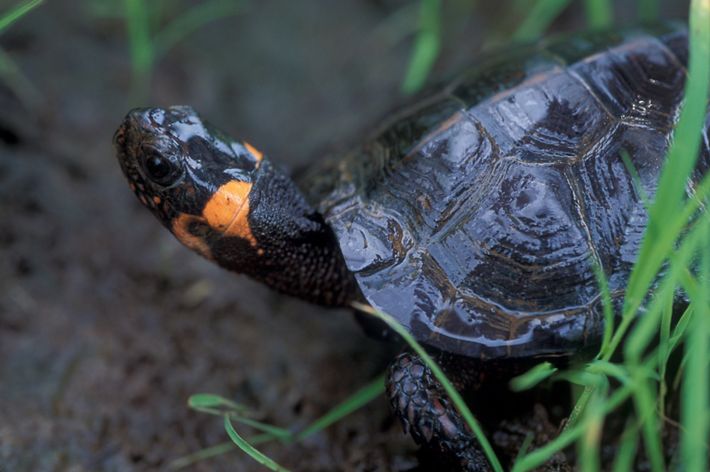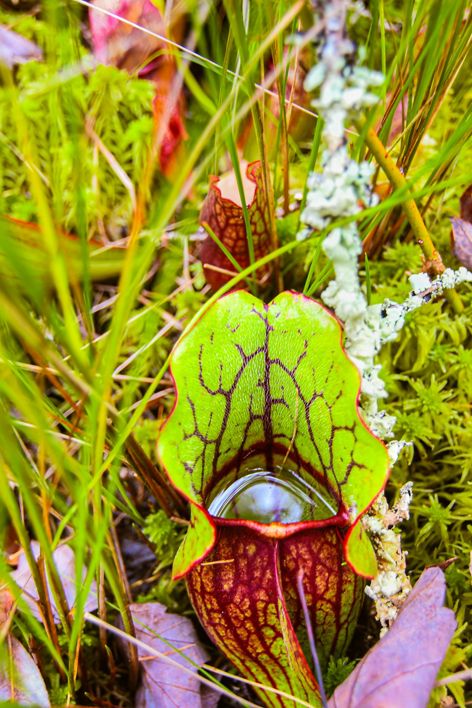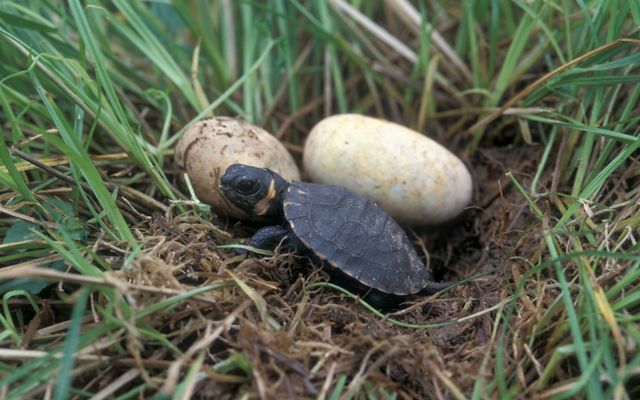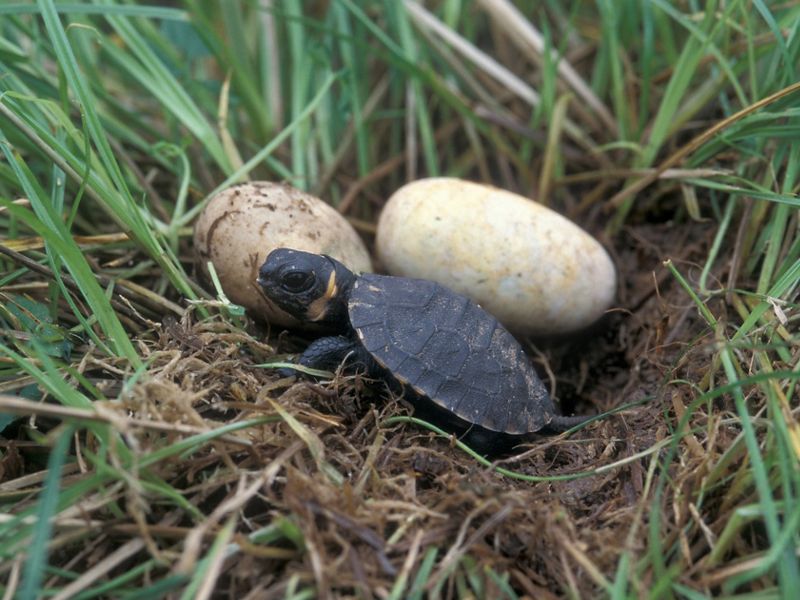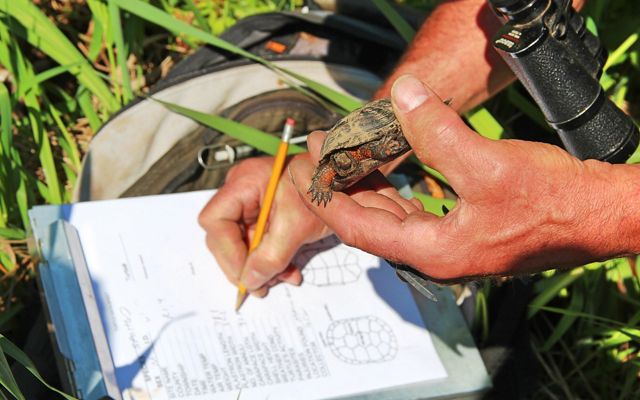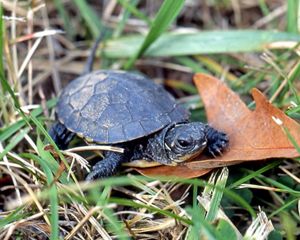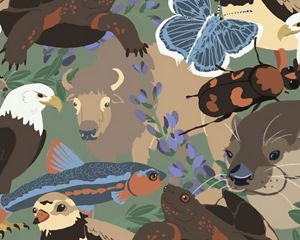
Bog Turtle (Glyptemys muhlenbergii)
Learn about The Nature Conservancy's work to save North America's smallest turtle.
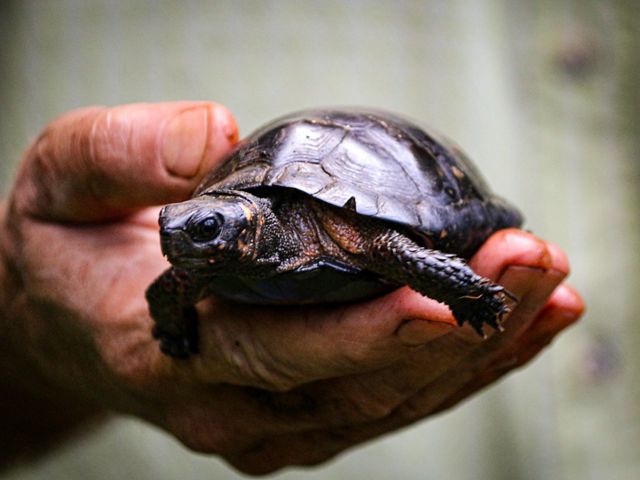
Fast Facts
Common name: Bog turtle
Scientific name: Glyptemys muhlenbergii
Conservation status: Critically Endangered (IUCN)
Lifespan: Oldest documented bog turtle was 62 years old
Size: 4.5 inches maximum length
Meet the Bog Turtle
The bog turtle is North America’s smallest turtle, growing only to 4.5 inches in length.
Easily recognized by the orange patch on either side of its head, the bog turtle favors open, groundwater-fed wet meadows and bogs dominated by tussock sedge and grasses.
Bog turtles thrive in mountain bogs, or isolated wetlands with acidic, wet soil, thick moss and deep layers of mud. These deep mucky soils, fed by groundwater, provide protection from predators and other elements. Short clumps of vegetation let in plenty of sunlight for incubating eggs and basking. If any of these conditions change, a bog turtle population can decline and may eventually disappear from the area.
Northern & Southern Populations
Bog turtles are native to the eastern United States.
The bog turtle occurs only in the eastern United States, with distinct northern and southern populations separated by a 250-mile gap through most of Virginia and West Virginia. The northern population is larger than the southern, with bog turtles occurring in northern Maryland, Delaware, eastern Pennsylvania, southern New York and most of New Jersey and extending as far north as Massachusetts. Although populations were once abundant in the Southern Blue Ridge of North and South Carolina and Georgia, the bog turtle is now facing unprecedented challenges to its survival.
Threats to Bog Turtles
The bog turtle is classified as federally threatened on the U.S. Fish and Wildlife Service’s Endangered Species List.

The bog turtles are classified as federally threatened and are often eaten by predators such as skunks, raccoons, and foxes, when in the egg. Once, hatched, bog turtle hatchlings are also vulnerable to birds, snakes, and small mammals
However, habitat loss, fragmentation and forest succession represent the primary reasons for the decline of this species. In the past, bog turtles could move to nearby habitats if conditions changed. However, the remaining habitats have become more isolated because of land development.
Loss of critical mountain bog habitat poses a major threat to the southern population of bog turtles, which tend to occur at higher altitudes than the northern population. Mountain bogs are important for a variety of reasons. In addition to the bog turtle, bogs provide homes for four endangered species, including green pitcher plants, mountain sweet pitcher plants, swamp pink, and bunched arrowhead. Migratory birds such as woodcock, grouse, turkey and wood duck stop in for a visit. They are also valuable breeding habitats for amphibians, particularly for salamanders. The Southern Appalachians are a hotspot for salamanders unequaled anywhere else in the country. There are also benefits to people. Bogs regulate water flow. When it floods, they will soak up water, which is gradually released to streams.
Bog turtles are also threatened by diminished water quality, mortality on roadways, growing populations of predators like raccoons and reptile collectors who consider this rare turtle a valuable prize. Adam Warwick, TNC’s Southern Blue Ridge Stewardship Manager, explains the risk of exposing bog turtles to the illegal pet trade. “If someone took a picture of a bog turtle and posted it on Instagram with the geolocation, a poacher could come in and wipe out a single bog turtle population in one night.”
How TNC is Protecting Bog Turtles

In Pennsylvania
In Pennsylvania, small, spring-fed streams trickle down South Mountain towards the sandstone valley below. In some areas, the water collects to form soft, muddy wet meadows, surrounded by clumps of grassy tussock sedges and other low-lying vegetation. Creating the ideal habitat for bog turtles.
In 1989, The Nature Conservancy acquired land near South Mountain to maintain and restore the habitat required by these turtles that are no larger than the palm of a human hand. Over the years, this work has included managing burns, cutting trees and introducing cattle and goat grazing in order to foster the growth of native vegetation and maintain the soft mucky soils that the turtles prefer.
TNC also conducted a radio telemetry study in Pennsylvania that documented bog turtle locations, hibernation, travel patterns and habitat use within the preserve. Studies have revealed the existence of a 62-year-old bog turtle, the oldest documented bog turtle known in the wild.
Many mountain bogs that used to be home to bog turtles in the southern population have been lost to development. There, Warwick leads the charge to restore mountain bog habitat for the turtle. “The work we do spans acquisition and protection, to management of habitat, to bolstering population,” he explains.
Beavers also once helped to create that habitat in the Southern Blue Ridge, but with their populations also in decline, TNC strives to maintain an open, grassy landscape with clear-cutting. Electric fencing and caging at bog turtle sites to protect them from predators and people are known techniques to enhance nesting success.
In Massachusetts
Hidden away in the wetlands of Western Massachusetts, a small-but-mighty bog turtle population is stabilizing—thanks to TNC and partners’ ongoing study of the endangered species and careful management of their habitat. Every April to November, TNC staff, interns, volunteers and others, radio track and search for turtles to help fill out the existing population data.
TNC in Massachusetts has been involved with monitoring the species since the 1980s, building a record of the number of turtles of certain ages, population growth and health, and turtle locations. This data helps inform the management strategies used to ensure the habitat is supporting turtles’ needs.
“Weekly tracking guides our restoration efforts by showing us what kinds of habitat they prefer for nesting, basking, foraging and overwintering,” says Angela Sirois-Pitel, stewardship manager for TNC in Massachusetts. “If turtles show up in areas where we recently removed invasive plants or opened up the canopy, it confirms that our management actions are beneficial.”
There are estimated to be less than 40 adult turtles at each of two sites TNC owns and manages in the area. Protecting bog turtles is key to sustaining the many other species found in these wetland ecosystems.
In the summer of 2020, 53 turtles were spotted through a combination of tracking those with transmitters and searching for them in the underbrush of the wetland. The number included both old and new individuals. Eight of the turtles that turned up have been around since the studies began in the 1980s, making them over 40 years old. In addition to these long-timers, another eight of the turtles found had never been seen before. These observations indicate that older turtles are still around and that the population is reproducing and those young turtles are growing into adults.
“These promising population numbers, paired with the observation that turtles are exploring areas of the habitat that we’ve recently opened up, are a positive sign that our habitat management strategies are working,” says Sirois-Pitel.
In 2021, University of Massachusetts graduate student and former TNC AmeriCorps member Julia Vineyard will begin her first field season studying the bog turtle populations in Massachusetts, in coordination with MassWildlife, building on the past two years of rigorous monitoring at these sites. Much of TNC’s ongoing research and restoration work has been funded through a MassWildlife Habitat Management Grant and a Natural Resource Damages Fund for the Housatonic River, and Julia’s continued study is supported by a U.S. Fish and Wildlife Service State Wildlife Action Grant.


Stay in Touch
Sign up to receive monthly e-mail conservation news & updates from your state.
